Storm-Proof Your 4th of July Inflatables with These Tips
Shield your 4th of July inflatables from summer storms with smart setup tips, anchoring tricks, and weatherproofing advice to keep your patriotic decor safe.
6/13/202510 min read
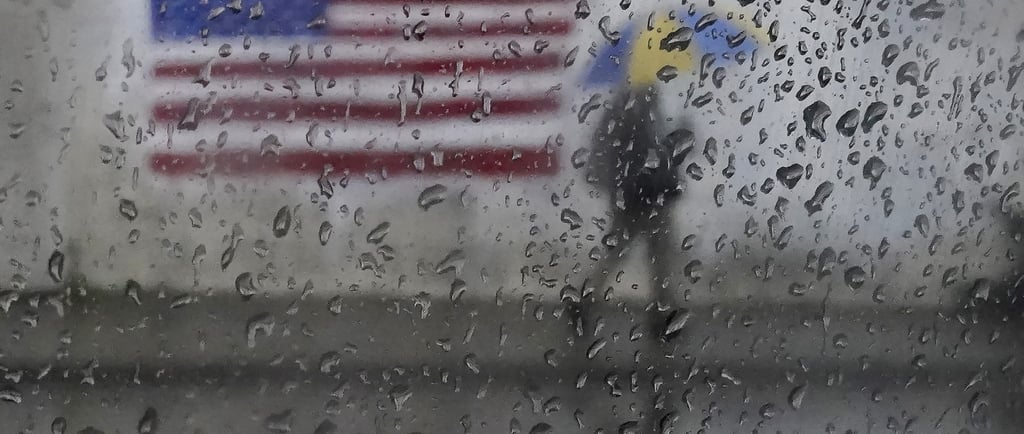

FAQ: Storm-Proof Your 4th of July Inflatables
Q1: How can I keep my 4th of July inflatables from blowing away in storms?
A1: Secure your inflatables with all provided tie-downs and stakes, upgrade to heavy-duty metal ground anchors, use sandbags for extra weight, and consider ratchet straps for large decorations. Also, avoid windy “tunnel” spots near fences or bushes.
Q2: What are the best ways to protect inflatables from rain and electrical hazards?
A2: Use outdoor-rated, GFCI-protected extension cords, elevate plugs and inflatables off the ground to prevent water pooling, seal connections with weatherproof covers or tape, and unplug your setup before storms arrive, ideally via a smart outdoor plug.
Q3: What safety tips should I follow on the day of the 4th of July?
A3: Inspect inflatables for damage each morning, unplug and deflate if winds exceed 20 mph, avoid leaving inflatables powered overnight during storm chances, and keep cords and decorations clear of walkways to stay safe and considerate.
Introduction:
Tired of chasing Uncle Sam across the lawn every time a summer storm hits? 🌩️ If your Fourth of July inflatables have ever taken flight, you’re not alone. July weather can be unpredictable—but with the right setup, your red, white, and blue display can stay safe and secure. In this guide, I’ll share battle-tested tips to anchor and protect your patriotic inflatables so they survive wind, rain, and whatever else summer throws your way. Let’s storm-proof your celebration using common-sense and some cool technology!!

Why Storm-Proofing Your Inflatables Matters (From Someone Who Learned the Hard Way)
Let me tell you—nothing deflates your holiday spirit faster than watching your patriotic eagle get launched down the street by a rogue gust of wind. It happened to me two summers ago during a sudden Flag Day storm. One minute, the sky was blue; the next, my inflatables were tangled in the neighbor’s hydrangeas. I’ve never forgotten the lesson.
Summer Storms Don't Wait for You to Unplug
If you live anywhere with unpredictable summer weather (looking at you, Midwest), you know how quickly storms can roll in. Your inflatables might look sturdy under the sun, but they’re incredibly vulnerable to wind, rain, and lightning if left unprotected. A heavy downpour or a sharp gust of wind is all it takes to turn your festive display into a flying hazard.
Smart Plugs = Smart Insurance
Here’s a tip I wish I’d known sooner: invest in a Wi-Fi smart outdoor plug that you can control from your phone. When you’re out shopping or at work and a storm warning hits, you can instantly power down your entire setup with a tap. No sprinting home in a panic. No fried fan motors.
Unsecured Inflatables Can Be Dangerous
I once saw an inflatable Santa (yes, in July… long story) crash into a parked car during a wind burst. These things are light when the air’s out, but fully inflated, they act like sails. If they break free, they can damage property—or worse, injure someone. Secure them with ground stakes and tether ropes like you mean it.
High Winds Rip, Tear, and Wreck
Patriotic inflatables might be built tough, but they’re not indestructible. Strong winds can yank seams, snap tethers, or flip over even the best-anchored displays. That kind of damage often isn’t worth repairing—especially if the fan motor gets compromised in the chaos.
Rain and Electricity Don’t Mix
Water damage is the silent killer of outdoor decor. If moisture seeps into the plug or motor housing, you could be looking at a short circuit—or a fire hazard. Always use outdoor-rated cords and weatherproof connectors, and elevate plugs off the ground with a brick or plastic container (I learned that one after nearly tripping on a soggy extension cord).
Storm-Proofing Protects Your Investment
Look, inflatables aren’t cheap. If you’re dropping $50 to $150+ on a patriotic display, protecting that investment should be part of your plan. A little foresight—checking the weather, securing lines, unplugging early—means you’ll get years of use out of each piece instead of watching them deflate (literally and emotionally) after one stormy season.
Bottom line? You don’t have to live in a hurricane zone to take storm-proofing seriously. It’s part of decorating responsibly—and it shows pride not just in your country, but in your neighborhood and your home. Ready to storm-proof with confidence?


How to Anchor Inflatables Against Wind (Because I’ve Chased One Down the Block)
You don’t truly appreciate the power of a summer gust until you’re running barefoot across your yard in a towel, chasing an airborne Uncle Sam down the sidewalk. True story. That was my Flag Day reality two years ago, and ever since then, I’ve taken wind anchoring very seriously.
Whether you live in a breezy valley or just want peace of mind when storms pop up, here’s exactly how I anchor my inflatables—so they stay put, look great, and don’t become the neighborhood meme.
1. Always Use the Provided Tie-Downs
I’ll admit—I used to skip the ropes and just trust the stakes alone. Big mistake. Most inflatables come with built-in loops, tethers, and basic ground stakes. Use them all. Seriously. Tie each rope securely and drive every stake in at a 45-degree angle, pulling the rope taut without stressing the seams. It creates the foundation your display needs.
2. Upgrade to Heavy-Duty Stakes for Windy Areas
The plastic stakes that come with most inflatables? They’re fine for calm days, but in gusty regions, they’re practically toothpicks. I’ve switched to metal spiral ground anchors—the kind you’d use to tether a tent or dog run. They screw into the earth and resist vertical pull, which makes a huge difference in holding tall or wide decorations in place.
3. Sandbags: The Secret Weapon
You’d never know it by looking at my setup, but almost every inflatable I own has at least one sandbag hidden underneath. I fill cheap canvas gym bags with play sand (available at any hardware store) and nestle them right at the base. It keeps things grounded, especially when the inflatable hasn’t fully inflated yet and is vulnerable to lifting. Bonus: they’re reusable and don’t harm the lawn.
4. Use Ratchet Straps for Oversized Inflatables
If you’re going big—a towering eagle or a Statue of Liberty—don’t rely on ropes alone. I’ve started using ratchet straps connected to heavy-duty ground anchors. Not only do they handle tension better than rope, but they allow you to fine-tune tightness and reduce bounce or swaying. Just make sure not to overtighten and stress the seams.
5. Be Smart About Placement
Wind tunnels are real—and sometimes, you create them without realizing it. Avoid placing inflatables between two houses, near chain-link fences, or against tall bushes. These structures can channel wind and intensify gusts, turning your display into a wind tunnel. I now scope out the wind patterns in my yard before setup and aim for open, low-exposure spots.
Final Thought
The goal isn’t just to keep your decor upright—it’s about keeping your neighborhood safe, your investment intact, and your dignity unscathed. After all, nothing says “amateur” like a deflated patriot wrapped around your mailbox. Anchor like a pro, and your inflatables will ride out the wind like champions.
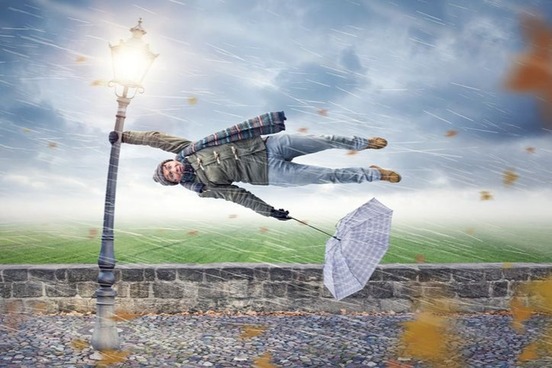

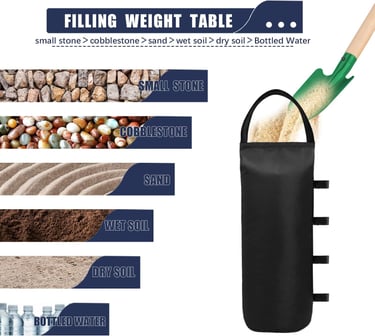

Weatherproofing for Rain and Thunderstorms (Because I’ve Watched a Firework Inflatable Fizzle Out in the Rain)
I remember standing at my front window one June evening, proud of my patriotic setup—flags waving, inflatables bobbing gently, the whole thing glowing red, white, and blue. Then the clouds rolled in. And let me tell you, nothing wipes the smile off your face faster than the sound of your $90 inflatable shorting out mid-thunderstorm.
After that wet disaster, I swore I’d never get caught unprepared again. Here’s everything I’ve learned—sometimes the hard way—about protecting your display when the skies turn mean.
1. Buy the Right Inflatables to Begin With
Not all inflatables are created equal. Look for ones made with heavy-duty weather-resistant nylon or polyester. If the listing doesn’t mention outdoor use or has reviews complaining about flimsy material or weak seams, skip it. I’ve had the best luck with brands like Gemmy and Home Accents Holiday, which explicitly design for outdoor conditions.
2. Raise Them Up—Literally
Water pooling at the base of your inflatable is a guaranteed way to ruin the motor. I use plastic pallets, recycled rubber mats, or even outdoor doormats underneath each inflatable to elevate them just enough so rain can run off instead of collecting around the blower. It’s subtle, but it makes a huge difference—especially if your yard tends to get mushy.
3. Protect the Power—Like Your Life Depends on It
Because sometimes, it kinda does. Always use GFCI (Ground Fault Circuit Interrupter) outdoor-rated extension cords. If you don’t know what that is, it’s a special plug that shuts off power instantly if water or moisture causes a short. It’s the single most important safety item you can add. I use this GFCI outdoor adapter with every yard display, no exceptions.
On top of that, seal plug connections with electrical tape or weatherproof outlet covers. I also elevate the cords themselves on bricks or rocks so they’re not sitting in puddles.
4. Weather Apps Are Your Best Friend
I use the MyRadar and AccuWeather apps religiously during decorating season. If a thunderstorm’s headed your way, unplug early—don’t wait until the wind starts whipping. I’ve got my entire display plugged into a smart outdoor outlet (like the TP-Link Kasa outdoor plug), which means I can shut it down remotely with my phone. It’s saved me from several storms while I was out of town.
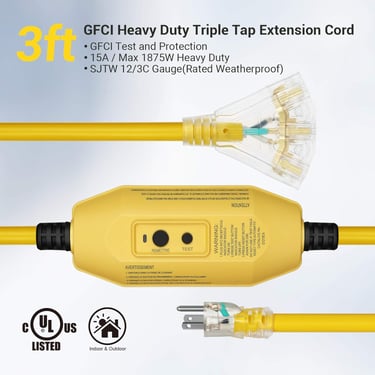

Quick Checklist: Storm-Proof Setup
✅ Inflatables rated for outdoor use
✅ Elevated base to prevent puddles
✅ Weather-sealed plug connections
✅ GFCI cords only
✅ Real-time weather alerts enabled
Day-of Safety Tips for the 4th of July (Because I’ve Learned the Hard Way)
I love the 4th of July—the cookouts, the firework shows, and the way my entire yard transforms into a mini patriotic carnival. But let’s be real: all that joy can come crashing down if safety isn’t your first priority.
One year, I got cocky. I inflated everything the night before, thinking, “What’s the worst that could happen?” Cue a surprise wind burst around 3 a.m. that turned my waving Uncle Sam into a toppled mess tangled in the bushes. Lesson learned.
Here’s what I now always do on the big day to keep my setup festive and safe:
1. Morning Inspection Isn’t Optional—It’s Non-Negotiable
Before I even think about plugging anything in, I walk the yard. I check every inflatable for rips, exposed wiring, or sagging tie-downs. A small seam tear might seem harmless in the morning, but give it five hours of sun and wind, and you’re dealing with a floppy, deflated eyesore.
Pro tip: Keep a roll of waterproof duct tape or a vinyl patch kit in your garage. It’s saved me more than once on short notice.
2. Know Your Wind Threshold—20 MPH Is the Magic Number
It doesn’t take a tornado to wreak havoc. If gusts start creeping past 20 mph (I use the Windy app to track in real time), I unplug and deflate. It’s just not worth the risk. I’ve seen tall inflatables whip around like dancing car lot mascots—and that’s when they’re seconds away from tearing or flying into your neighbor’s yard.
3. No All-Nighters—Especially if There’s Weather Coming
As tempting as it is to let your display glow all night, don’t do it if there’s even a 10% chance of a storm. I set a schedule using a Kasa Smart Plug so everything powers down around 10:30 PM. If there's a storm forecast, I manually shut it down earlier. Trust me—waking up to a fried fan or shredded nylon isn’t patriotic. It’s just sad.
4. Be a Good Neighbor
Is your 8-foot eagle blocking a shared walkway? Are your cords stretched across the sidewalk like a tripwire? If yes, that’s not patriotic—that’s inconsiderate. I’ve had friendly chats with neighbors who appreciated the heads-up before I set up anything too close to our fence line. It’s an easy win that avoids complaints (or worse, HOA notices).
Final Thought
Look, we decorate because we love this country and want to celebrate it loud and proud. But the best displays are the ones that last—safely, respectfully, and responsibly. So treat your 4th of July setup like you would a fireworks show: full of awe, but never without caution.
Let freedom ring—and let your inflatables survive the day!
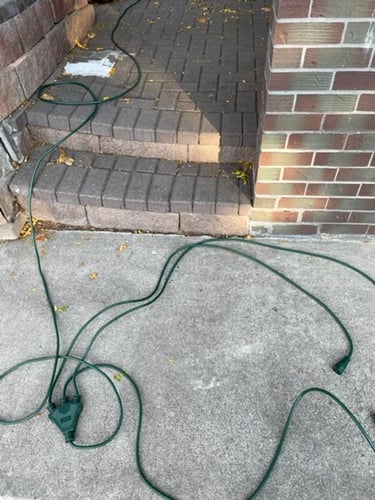

Conclusion:
Inflatable decorations add so much charm and excitement to your 4th of July setup, but they need a little TLC when summer storms roll in. By properly anchoring, weatherproofing, and staying alert, you’ll keep your decor secure—and your celebration stress-free.
Take it from someone who once spent an entire barbecue chasing a rogue inflatable firecracker across the cul-de-sac—it’s worth the prep. So this year, stay storm-ready and let your patriotic spirit soar (without your inflatables doing the same)!
Related articles:
Patriotic Inflatable Decoration Tips: Red, White & Blue Ideas
The Best Maintenance & Safety Hacks for Holiday Inflatables
Protect Inflatables from Rain Damage: Simple Tips
5 Professional Methods for Securing Holiday Inflatables
Defending Your Holiday Inflatables from Snow, Wind, and Pets
